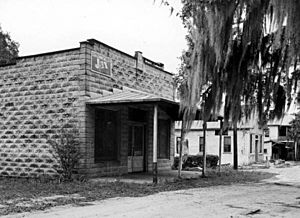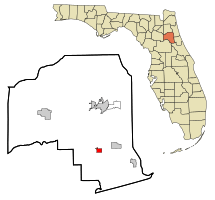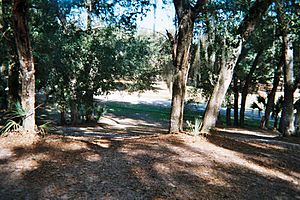Welaka, Florida facts for kids
Quick facts for kids
Welaka, Florida
|
|
|---|---|
| Town of Welaka | |

Brick building along commercial strip, November 1946
|
|
| Motto(s):
"Bass Capital of the World"
"River of Lakes" |
|

Location in Putnam County and the state of Florida
|
|
| Country | |
| State | |
| County | Putnam |
| Settled | 1852 |
| Incorporated | April 23, 1887 |
| Government | |
| • Type | Mayor-Council |
| Area | |
| • Total | 1.51 sq mi (3.91 km2) |
| • Land | 1.47 sq mi (3.82 km2) |
| • Water | 0.04 sq mi (0.09 km2) |
| Elevation | 26 ft (8 m) |
| Population
(2020)
|
|
| • Total | 714 |
| • Density | 484.40/sq mi (187.03/km2) |
| Time zone | UTC-5 (Eastern (EST)) |
| • Summer (DST) | UTC-4 (EDT) |
| ZIP code |
32193
|
| Area code(s) | 386 |
| FIPS code | 12-75750 |
| GNIS feature ID | 0306568 |
Welaka is a town situated on the St. Johns River in Putnam County, Florida, United States. The town is part of the Palatka, Florida Micropolitan Statistical Area. The population was 714 as of the 2020 census, up from 701 at the 2010 census.
History
It is not known when the area was first settled, but the nearby Mount Royal archaeological site is a possible remnant of a Timucua tribal village from c. 1250 CE to 1500 CE, and may have a connection to the town of Enacape, an important center of the Utina tribe.
The settlement was originally a 500-acre tract purchased by James William Bryant in 1852, and was known as Mt. Tucker. Prior to the war, there were large orange groves and cotton plantations. In 1860, Welaka's population was slightly over 100. At the end of the Civil War, fewer than 20 remained. The community grew again, and was officially incorporated on April 23, 1887, and was named the "Town of Welaka"; the name Welaka is said to have been derived from the word local Native Americans used for the St. Johns River. By the 1880s, Welaka had become a resort town, marketing itself to visitors seeking medicinal cures from the mineral water of the local springs. The Welaka Mineral Water Company was incorporated in 1907.
Geography
Welaka is approximately 90 miles south of Jacksonville and is accessible by highway or the Atlantic Ocean via the St. Johns River. The exact coordinates for the town is located at 29°28′54″N 81°40′18″W / 29.48167°N 81.67167°W (29.481556, –81.671555).
According to the United States Census Bureau, the town has a total area of 1.4 square miles (3.6 km2), of which 1.4 square miles (3.6 km2) is land and 0.04 square miles (0.10 km2) (2.86%) is water.
Climate
The climate in this area is characterized by hot, humid summers and generally mild winters. According to the Köppen climate classification, the Town of Welaka has a humid subtropical climate zone (Cfa).
Demographics
| Historical population | |||
|---|---|---|---|
| Census | Pop. | %± | |
| 1900 | 215 | — | |
| 1910 | 294 | 36.7% | |
| 1920 | 350 | 19.0% | |
| 1930 | 409 | 16.9% | |
| 1940 | 457 | 11.7% | |
| 1950 | 459 | 0.4% | |
| 1960 | 526 | 14.6% | |
| 1970 | 496 | −5.7% | |
| 1980 | 492 | −0.8% | |
| 1990 | 533 | 8.3% | |
| 2000 | 586 | 9.9% | |
| 2010 | 701 | 19.6% | |
| 2020 | 714 | 1.9% | |
| U.S. Decennial Census | |||
2010 and 2020 census
| Race | Pop 2010 | Pop 2020 | % 2010 | % 2020 |
|---|---|---|---|---|
| White (NH) | 508 | 497 | 72.47% | 69.61% |
| Black or African American (NH) | 159 | 123 | 22.68% | 17.23% |
| Native American or Alaska Native (NH) | 1 | 2 | 0.14% | 0.28% |
| Asian (NH) | 2 | 2 | 0.29% | 0.28% |
| Pacific Islander or Native Hawaiian (NH) | 0 | 0 | 0.00% | 0.00% |
| Some other race (NH) | 0 | 3 | 0.00% | 0.42% |
| Two or more races/Multiracial (NH) | 7 | 33 | 1.00% | 4.62% |
| Hispanic or Latino (any race) | 24 | 54 | 3.42% | 7.56% |
| Total | 701 | 714 | 100.00% | 100.00% |
As of the 2020 United States census, there were 714 people, 501 households, and 160 families residing in the town.
As of the 2010 United States census, there were 701 people, 227 households, and 149 families residing in the town.
Points of interest
- Welaka National Fish Hatchery
- Mount Royal
- Welaka State Forest
See also
 In Spanish: Welaka para niños
In Spanish: Welaka para niños


